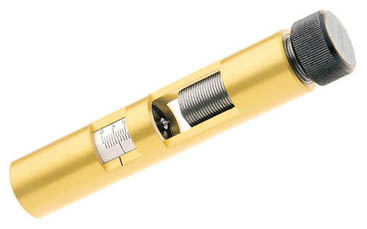Description
A precision instrument to accurately determine the hardness of a bullet casting
alloy.
SAECO Lead Hardness Tester will pay for itself many times over by allowing you
to convert inexpensive scrap lead of unknown composition into casting alloy of
known and reproduceable hardness. It provides a standard by which you can check
the quality of purchased cast bullets.
The SAECO Lead Hardness Tester
measures alloy hardness by determining the depth of penetration of a hardened
steel indenter into a bullet. Relative hardness of the bullet is read off a
vernier scale.
| Relative Hardness | ||
| SAECO | Brinell (Approx.) |
|
| Pure lead . . . . . . . . . . . | 0-1 | 5 |
| 1:20 tin: lead . . . . . . . . | 6-7 | 10 |
| 5:5:90 tin: | ||
| antimony: lead . . . . . | 7-8 | 15 |
| 2:6:92 (taracorp) . . . . . | 8-9 | 16-17 |
| (magnum alloy) | ||
| 5:10:85 (linotype) . . . . | 9-10 | 22 |
The vernier scale is calibrated in arbitrary units from 0 for pure lead up to a SAECO hardness of 10. We have found that a SAECO hardness of at least 6 is required for medium velocities in handguns and a SAECO hardness of over 8 for Magnum handgun and gas check rifle bullets. As a point of reference, wheelweights vary in composition and hardness but usually test between 7 and 9, while linotype registers approx. 10.







